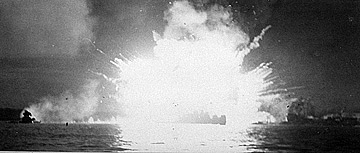
|
In the Military
Gregg K. Kakesako
|
36 killed in blast to be recognized
The grave markers of 36 sailors, who were killed in one of the best-kept secrets of World War II and never identified, will be changed to honor where they died during the 1944 West Loch disaster in Pearl Harbor.
On May 21, 1944, without warning, a munitions explosion on one of 29 Navy landing ships set off a chain reaction that killed 163 men and wounded 396 in an incident that was a Navy secret until 1960.
The only reminder of the disaster today is the rusting bow of LST 480, overgrown by weeds near the Waipio Peninsula. Thirty-six sailors were never identified and are buried under a grave marker in four different areas of the 116-acre National Cemetery of the Pacific at Punchbowl.

STAR-BULLETIN FILE PHOTO
On May 21, 1944, a munitions explosion on a Navy landing ship at West Loch killed 163 men.
|
|
Yesterday, U.S. Rep. Ed Case said he was told Thursday by Veterans Affairs Secretary James Nicholson that Punchbowl's "cemetery director will order new markers to replace the existing stones marking the graves of these 36 unknown sailors." Until last week, the VA said policy prevented changing grave markers unless a mistake was made in the inscription or damaging or weathering required a replacement.
A spokesman for Punchbowl yesterday said the cemetery hasn't received any directions on the change. James Messner, Punchbowl spokesman, said the only information he has seen on the matter is Nicholson's letter to Case.
Case said the replacement markers are supposed to say: "Unknown; West Loch Disaster; Pearl Harbor; May 21, 1944." Case credited Pearl Harbor historian Ray Emory, who also is a Pearl Harbor survivor, for forcing the change. Emory also is credited for a change in the law that allowed for the date and ship names on the grave markers of unknown sailors who died while serving on the USS Arizona when the Japanese attacked in 1941.
The U.S. Senate has approved an omnibus veterans bill that includes provisions that U.S. Sen. Daniel Akaka believes could avert the long-term care crisis in Hawaii, especially in rural areas.
Two of the provisions in the bill inserted by Akaka, who is a ranking member of the Veterans Affairs Committee, would allow states to establish state veterans' homes to meet long-term care needs in less-populated areas and require the Department of Veterans Affairs to pay full costs for certain service-connected veterans living in state veterans homes.
The measure, which was approved by the full Senate on Thursday, still has to clear a conference committee with House. Other Akaka provisions would:
» Authorize a pilot program to provide caregiver assistance and non-institutional care services.
» Extend the state cemetery grant program eligibility to tribal organizations to provide Native American veterans burial options.
» Increase the amount of supplement life insurance coverage available to disabled veterans from $20,000 to $30,000.
Last year, Akaka held hearings on the problem, pointing out that there are 40,759 veterans in Hawaii older than 65, but only 60 VA nursing home beds in the state. Nearly all the beds at the VA Center for Aging are filled on any given day.
During hearings on Kauai, he noted that there is a problem with access to long-term care there, including a lack of hospital beds and doctors.
"This timely piece of legislation includes a number of important provisions that will improve the health care and benefits that our nation's veterans deserve," said Akaka in a written statement. "It is particularly important that we remain vigilant in our support of those who serve in the Armed Forces, especially now in a time when so many brave men and women are in harm's way."
"In the Military" was compiled from wire reports and other sources by reporter
Gregg K. Kakesako, who covers military affairs for the Star-Bulletin. He can be reached by phone at 294-4075 or by e-mail at
gkakesako@starbulletin.com.

